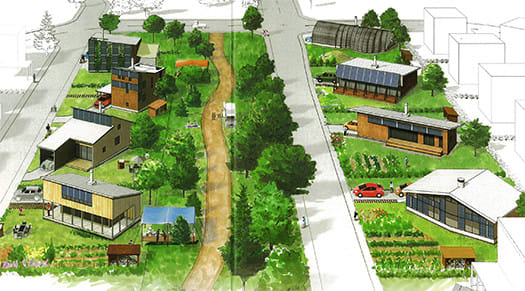

コロナによる社会閉塞からの停滞を経験して、その間に水面下で動き続けてきていたさまざまな社会の動向を反映した「住宅」の変化について、ひとつの象徴的なプロジェクトが動き始めている。
きょう紹介する「みどり野ゼロカーボンヴィレッジ」の先行形態として北海道の住宅施策の見える化にとり組んだ2018年段階の「きたスマイルヴィレッジ」について紹介した2018/6/2の拙ブログの「前文」部分を以下に、再掲します。
〜全国の地域自治体の中で、北海道はきわめて特異に「地域の家づくり」について緊密な関与を継続してきました。
明治の開拓期から、いまの「北海道庁」のルーツと言える「開拓使」がこの日本民族家屋文化にとってきわめて過酷な寒冷気候条件のなかでいかに安定的な「室内環境」を構築できて、その結果として多くの移民を実現できるかを必死に模索してきた。
明治国家にとってまさに近代国家への飛躍をかけた民族的チャレンジだった。
その歴史的な経緯はいまに至って、日本でもっとも「住宅性能」についての知見とそこに至る試行錯誤が折り重なった,独自の住宅文化を積層させている。そんな150年からの「余熱」はいまに至っても確実に存在している。〜
この精神はいまに至る北海道の独自の「住宅施策」の根底にあり続けていると思います。こうした精神を今日に活かすべく、北海道では地域独自の「住宅施策会議」を継続してきている。そのメンバーとして参加させていただいて、地域の住宅リアルタイム情報やNPO住宅110番というユーザー視点といった立場から、意見を申し上げてきた次第です。
昨日、その施策検討会議が開かれて「今日版」として「みどり野ゼロカーボンヴィレッジ」についての一般向け冊子も開示されていました。やはり、施策会議で論議してきた方向性がさまざまに具現化され、見える化されていることが明確でした。北海道住宅のリアルタイムの状況は、各地域でいま実際に建てられているので、それを参観すれば理解できるでしょうが、大きな意味での「地域」総体が目指している方向性は、こういった未来志向の住宅コンセプトに可視化されている。
そういった意味で「目指しているもの」コンセプトブックとでも言えるでしょうか。
北海道らしく「建築家と地域工務店が創るクオリティファーストの住まい」というように日本全体の住宅建築の性能とデザインの方向性を創り出す主体を明示させている。国交省主導の住宅施策とはこの立脚点に於いて相違があるのだと思う。国の住宅施策では、この北海道のような明確な「作り手主体」の明示化は困難。
再度、あらたな胎動をはじめた北海道住宅の姿に触れていきたい。地域の作り手たちが、どんなテーマ意識を持ち、それを現実化させようとしているのか、個別に見ていきたい。あした以降、コンセプトブックの各事例をウォッチしていきたいと思います。
English version⬇
2024 Imadoki-Hokkaido Housing Goals and Visualization in Minami-Horo
Yesterday, we had a meeting to discuss the direction of the Hokkaido Housing Policy Conference for 2023 and the new fiscal year. We would like to propose a house building concept that reflects the discussions. ...
One symbolic project is beginning to move forward regarding changes in "housing" reflecting various social trends that have been moving under the surface during the stagnation experienced from the social blockage caused by the Corona.
The "Preamble" section of my blog of 6/2/2018, in which I introduced the "Kita Smile Village" as a precursor to the "Midorino Zero Carbon Village" that I introduce today, which is a 2018 stage of visualizing housing policies in Hokkaido, is reproduced below.
〜Hokkaido has been very unique among regional governments across the country in maintaining close involvement in "local home building".
Since the Meiji era, the Kaitakushi (Hokkaido Development Office), which is the root of today's Hokkaido Government, has been desperately searching for ways to create a stable "indoor environment" in the extremely harsh cold climate conditions for the Japanese house culture, and as a result, to achieve a large number of immigrants.
For the Meiji nation, this was truly a nationalistic challenge to make the leap to a modern nation.
This historical background has now led to the accumulation of a unique housing culture in Japan that is the result of a combination of knowledge of housing performance and the trial and error that led to it. The "residual heat" from the past 150 years certainly still exists today. 〜The spirit of the "residual heat" from the past 150 years is still present today.
This spirit continues to be at the root of Hokkaido's unique housing policies to this day. In order to keep this spirit alive today, Hokkaido has continued to hold regional "housing policy meetings. I have participated as a member of these meetings, and have expressed my opinions from the standpoint of real-time information on housing in the region and the user perspective of the NPO Housing 110.
Yesterday, the policy review meeting was held, and a booklet for the general public on the "Midorino Zero Carbon Village" was disclosed as "today's edition". As expected, it was clear that the directions discussed at the policy meeting have been materialized and visualized in various ways. The real-time status of Hokkaido housing can be understood by observing actual construction in each region, but in a larger sense, the direction that the entire "region" is aiming for is visualized in these future-oriented housing concepts.
In this sense, it could be called a concept book of "what we are aiming for.
The "Quality First Homes Created by Architects and Local Builders," as is typical of Hokkaido, makes explicit the entity that will create the direction of performance and design for housing construction in Japan as a whole. I think there is a difference in this standpoint from the housing policy led by the Ministry of Land, Infrastructure, Transport and Tourism. In the national housing policy, it is difficult to clearly specify the "creator subject" as is the case in Hokkaido.
I would like to touch again on Hokkaido's housing, which has begun to take on a new form. I would like to look at each of the local makers individually to see what kind of thematic awareness they have and how they are trying to make them a reality. From tomorrow onward, we would like to watch each case study in the concept book.



















